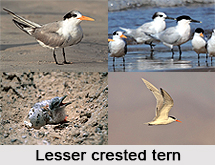 Lesser Crested Tern is an Indian bird that bears a scientific name "Thalasseus bengalensis" and is a seabird of the tern family Sternidae.
Lesser Crested Tern is an Indian bird that bears a scientific name "Thalasseus bengalensis" and is a seabird of the tern family Sternidae.
Breeding of Lesser Crested Tern
Lesser Crested Tern breeds in subtropical coastal parts of the world mainly from the Red Sea across the Indian Ocean to the western Pacific and Australia, with a significant population on the southern coast of the Mediterranean on two islands off the Libyan coast. Accidental breeding has also been reported in Italy and France. Australian Lesser crested tern are probably sedentary, but other populations are migratory, wintering south to South Africa.
Nests of Lesser Crested Tern
Lesser Crested Tern breeds in dense colonies on coasts and islands of the sub tropical countries like India, Bangladesh and Pakistan. It nests in a ground scrape and lays one to two (rarely three) eggs. Nesting behaviour is very similar to that of Sandwich terns, with predator avoidance by nesting in very dense colonies, and also by nesting in the late summer when predatory yellow-legged gulls have finished breeding and departed from the nesting area.
Feeding of Lesser Crested Tern
Lesser Crested Tern feeds by plunge-diving for fish, usually from saline environments. It usually dives directly, and not from the "stepped-hover" favoured by Arctic tern. The offering of fish by the male to the female is part of the courtship display.
Structure of Lesser Crested Tern
Lesser Crested Tern is a medium-large tern, very similar in size and general appearance to its three very close relatives Sandwich tern, elegant tern and Chinese crested tern. The summer adult has a black cap, black legs and a long sharp orange bill. The upper wings, rump and central tail feathers are grey and the under parts white. The primary flight feathers darken during the summer. In winter, the forehead becomes white. The call is a loud grating noise like Sandwich tern.
Distinguished Feature of Lesser Crested Tern
The grey rump of Lesser Crested Tern is useful for flight and it is one of the identification features. Lesser Crested Tern also differs in a slightly longer, slenderer bill, while Chinese crested tern differs in a black tip to the bill and Sandwich tern a black bill with a yellow tip. The juvenile lesser crested terns resemble same-age Sandwich terns, but with a yellow-orange bill and paler overall, with only faint dark crescents on the mantle feathers.



















